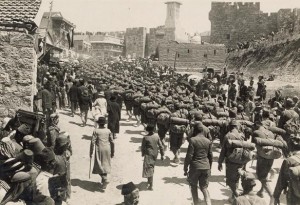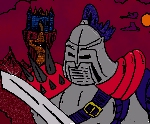This is mark Joseph “young” blog entry #23, on the subject of Armageddon and Presidential Politics.
A popular atheist recently suggested that Presidential candidates, and particularly Republican candidates, needed to be asked a theological question: do you believe that the end of the world is imminent, and if so is that a good or a bad thing? If war in the Middle East is positioned to blossom into Armageddon and the return of Christ, do we want to prevent the war, or encourage it?

That might be a good question for a potential leader of the most powerful military forces in the world, but it might also be a good question for the rest of us. At least, we should consider what answer our leader ought to give.
Despite what many prophecy teachers say, the sequence of events leading to the end of the world is not at all clear–some predictions touted as major parts of some theories are almost certainly predicting the destruction of Jerusalem in 70 A.D. by Titus. I have briefly reviewed the major theories (in The Sandy Becker Theory of Eschatology) along with some of the strengths and weaknesses of each and why I believe we cannot resolve the matter. However, there are many who are quite persuaded of one theory or another, and the one currently in ascendancy, indeed since early in the twentieth century, has been a version of “pre-millenialism” (if you do not know what that is, read the other article and return) in which Israel plays a major role and there is a massive world war centered in the Middle East. Every skirmish that occurs in the region, from the battles which took the territory from the Ottoman Empire in World War I to the Yom Kippur War to the current Islamic State battles, sparks anew the expectation that this might be the fight that brings all the armies of the world together to be defeated by the return of Christ.
The return of Christ is an event which Christians around the world have been anticipating for nearly two millennia, whatever our beliefs concerning what precipitates it. Late in the first century, the book variously known as The Revelation (from the Latin for “unveiling”) or The Apocalypse (from the Greek for “uncovering”) introduced to the faith the word which in English we make “Maranatha”, “Come, Our Lord” (although whether the original was marana tha, “Come our Lord”, or maran atha, “Our Lord has come”, is a question that cannot be settled from the manuscripts). We are instructed to watch for that coming, to anticipate it, to be prepared for it, even to want it and to work to hasten it–and in times when the world is falling into chaos and wickedness and darkness, it is easy to want it more.
On the other hand, we are told by Peter that the delay is an expression of God’s mercy: the moment Jesus returns, the door closes, and anyone who has not entered may not do so. It does not seem to be our place to call for the end of mercy, the closing of the door, and many of us would not do so merely because we have family or friends or colleagues who have not turned to Christ for forgiveness and salvation. I would rather not see strangers excluded from grace, and while I often note that there is no one apart from myself I am completely certain without any doubt has been forgiven and accepted by God, with varying degrees concerning other specific persons from “almost certainly” to “probably not”, I am not really in a hurry to have God terminate the free limited-time offer of acceptance into His family, and I don’t think that other believers should be so, either. Don’t get me wrong: I would love to have gone home already, if I were the only person who mattered. I just don’t think that I’m the only person who matters, even to me, nor to most believers in the world, and certainly not to God.
How, then, do we hasten the return of Christ and the end of the world, without hastening the end of the world as a path to the return of Christ?
The first thing we need to understand is that the one leads to the other, but the other is not the path to the one. That is, whether or not theories about a literal military battle at the Valley of Megiddo (har-megeddon) in which all the armies of the world are defeated in combat against an angelic host led by the resurrected and returning Jesus, we do not make that happen, indeed, we are completely unable to cause that to happen, by leading the world into war in the region. The return of Christ brings the end of the world as we know it, but it is possible that the world as we know it could end without bringing the return of Christ–indeed, arguably that has happened several times in history, most notably with the fall of the Roman Empire.
The second thing to grasp is that if such a battle is in fact the solution to the mysteriously metaphorical explanations of future events in John’s great apocalyptic vision, we will not be able to prevent it–but that does not mean we are not obligated to attempt to do so. “God has called us to peace,” and while that was Paul’s reason in I Corinthians for why a Christian whose spouse had been unfaithful should let the unfaithful spouse decide whether to preserve the marriage or get divorced, it is used as a fundamental principle of Christian conduct: we do not pick fights. We were instructed once by Christ to take swords with us if we had them, so we certainly have a basis to justify fighting when it is clearly necessary (and to debate just what fights are clearly necessary and when the right choice is to suffer the injury, to “turn the other cheek”). Yet our preference should always be for the peaceful resolution, even while keeping our sword within reach.
So for our Presidential candidates, the “right” answer to the question is probably this:
I eagerly anticipate the return of Christ, and whatever events will lead up to that, but I do not know with any certainty what those events are and will not be party to a war we can avoid honorably for any reason other than it is necessary for the safety of this country and the world in terms that persons of every faith or no faith can at least recognize as plausibly legitimate.
That is also the answer we should give if we are asked that question.
[contact-form subject='[mark Joseph %26quot;young%26quot;’][contact-field label=’Name’ type=’name’ required=’1’/][contact-field label=’Email’ type=’email’ required=’1’/][contact-field label=’Website’ type=’url’/][contact-field label=’Comment: Note that this form will contact the author by e-mail; to post comments to the article, see below.’ type=’textarea’ required=’1’/][/contact-form]

